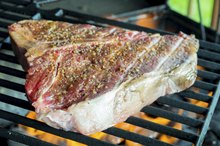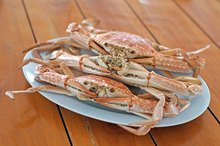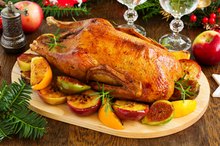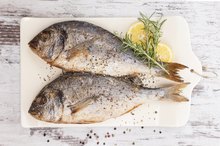Nutritional Values of Meat & Fish
Meats such as fish, poultry, pork and beef contain essential nutrients such as protein and iron. People who do not eat meat can still get these nutrients from food sources, but must eat a combination of plant-based foods in order to get the same nutrients found in one serving of meat. A serving size for most types of meat and fish is about 3 oz., or roughly the size of a deck of playing cards.
Benefits
Meat and fish are complete sources of protein, containing the nine amino acids that the body requires but cannot make for itself. Protein serves several important functions in the body, including tissue growth and repair. Meat and fish also contain heme iron, which is more useful to the body than non-heme iron, the type of iron found in plant-based foods. Iron is essential for healthy muscle growth and blood oxygenation. The Recommended Dietary Allowance, or RDA, for iron is about 8 mg per day for men, 18 mg for women and 10 mg for children.
Risks
Gyro Meat Nutritional Information
Learn More
Depending on the type and cut, meats can be high in fat and cholesterol. The University of Kentucky Cooperative Extension Service recommends that only about 30 percent of daily calories should come from fat, and that people should not consume more than 200 mg of cholesterol per day. According to the Vegetarian Resource Group, only about 10 percent of daily calories should be from protein sources. Over-consumption of protein may contribute to kidney disease.
Certain types of fish, such as swordfish and king mackerel, are high in mercury. The Department of Health and Human Services recommends that women who are nursing or pregnant avoid eating high-mercury fish.
Beef
A 3-oz. serving of beef sirloin contains about 170 calories, 22 g of protein, 1.5 mg of iron, 7 g of fat and 76 mg of cholesterol. Ground beef is typically graded by fat content. Seventy-five percent lean is one of the highest-fat grades available, containing 235 calories, 15 g of fat and 75 mg of cholesterol per serving. Beef cuts labeled loin or round tend to be lower in fat than other cuts.
Pork
How Much Protein Is in a Filet of Flounder?
Learn More
Pork tends to be higher in cholesterol than other types of meat. For example, pork tenderloin, one of the leanest cuts of pork available, contains about 160 calories, 22 g of protein, 0.83 mg of iron, 5 g of fat and 80 mg of cholesterol per 3 oz. serving. Other cuts of pork are much higher in calories, such as bacon, which contains about 457 caloreis per 3 oz. serving.
Poultry
Turkey is the highest-protein poultry with about 23 g per 3 oz serving, followed by duck with 20 g and chicken with 18 g. Poultry is leaner than most cuts of beef and pork, but also contains less iron. For example, chicken breast contains about 142 calories, 0.32 mg of iron, 3 g of fat and 73 mg of cholesterol per 3 oz. serving.
Fish
The National Institute of Health’s Medline Plus program recommends fish as a lean protein alternative to red meat. For example, a serving of pink salmon contains only about 127 calories, 4 g of fat and 57 mg of cholesterol. Most types of fish contain about 20 to 25 g of protein and 0.33 mg of iron per serving. Fish also contains omega-3 fatty acids, which support brain and neural development.
Related Articles
References
Resources
Writer Bio
Layne Wood began writing in 1990. Her work has appeared in publications by the Big South Undergraduate Research Symposium and Appalachian Writers Heritage Symposium. Wood specializes in articles on Appalachia, literature, dogs and relationships. She has a Bachelor of Science in English from Radford University.









